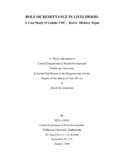Please use this identifier to cite or link to this item:
https://elibrary.tucl.edu.np/handle/123456789/2297| Title: | Role of Remittance in Livelihood |
| Other Titles: | A Case Study of Gokule VDC, Kavre District, Nepal |
| Authors: | LAMA, SITA |
| Keywords: | Remittance;Economic conditions |
| Issue Date: | Aug-2016 |
| Publisher: | Central Department of Rural Development Tribhuvan University, Kathmandu |
| Abstract: | A thesis entitled Role of Remittance in Livelihood : A Case Study of Gokule VDC, Kavre District, Nepal. The main objectives of this study are to find out the role of remittance in livelihood the selected Gokule VDC – 3 and 4, Kavre. This study was based on the qualitative and quantitative both methods. This study has been based on the primary as well as secondary data. 36 households were selected for my study The most of the respondents are decided to go abroad by the process of employment agency 5.6 percent followed by relatives and friends 8.3 percent, brokers 41.7 percent, and family members 44.4 percent. It shows most of the migrants depend on employment agency. The highest percent migrants are migrated due to high wage rate (5.6 percent), followed by easy availability of work (41.7 percent), easy entry and exit (22.2 percent) and social relationship (30.6 percent). The destination countries of Nepalese emigrants. Highest proportion (38.9 percent) migrants go in Gulf countries followed by (30.9 percent) migrants go others countries and (30.9 percent) migrants go in India. It shows that gulf countries are main destination of Nepali labour migrants. The occupational status of labour emigrants after going abroad. Drivers are highest than other occupations, which is 36.1 percent followed by labor 19.4 percent and others 2.8 percent. This study concludes that the majority of migrants have either below the primary level of neither education nor illiteracy. Almost all the youths are leaving their study because of the trend of going abroad with friends and neighbours. Unemployment, lack of agricultural land and low level of agricultural production are important factors for migration. Likewise, higher wage rate, demonstration effects and presence of friends/relatives at the destination place and no need of special skills and higher education are other important factors associated with destination. The large part of remittance is being used in unproductive sectors like construction of houses, ornament buying, household consumption, buying land, alcohol and other individual purpose. Besides agricultural sector, there are not any options to invest and reinvest remittance. There are not any cottage industry and manufacturing industries also. Similarly, saving proportion is very low. |
| URI: | http://elibrary.tucl.edu.np/handle/123456789/2297 |
| Appears in Collections: | Rural Development |
Items in DSpace are protected by copyright, with all rights reserved, unless otherwise indicated.

